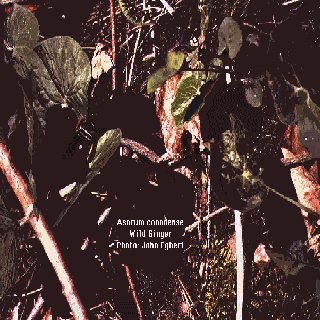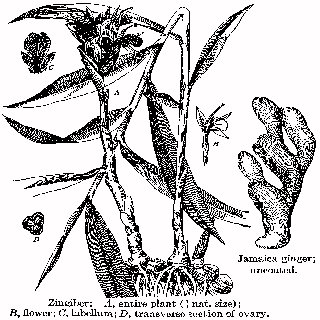

What is Ginger? This section is compiled by Frank M. Painter, D.C.
Send all comments or additions to: Frankp@chiro.org




Thanks to the University of North Carolina School of Pharmacy for the use of this article!
Allison Solomon and Jennifer BakerIt’s Not Just For Cooking

Description of Plant:
Stem rises 2 to 3 feet, with green leaves and greenish-yellow flowers streaked with purple. It stands erect and is enclosed by a protective sheathing
World Region:
India is largest producer. Cultivated in other areas including Africa, Southeast Asia, and West Indies. Will grow in areas that produce plentiful rainfall and sunlight.
Part Harvested:
Activity is due to the ginger oleoresin (volatile oil and resin) located within the rhizome. A rhizome is an underground stem.
History and Folk Use:
Ginger was utilized in China as a medicinal agent 2,500 years ago. They used it for abdominal distensions, coughing, vomiting, diarrhea, rheumatism, and toothaches. The Nigerians also used ginger to treat yellow fever and malaria. In the West Indies, they used it for urinary tract infections. Over 25% of Indians still prepare a cough syrup made out of honey and ginger to treat the common cold.
Medicinal Effects:
Gingerol is a component of the ginger oleoresin and is responsible for ginger’s medicinal effects. It possesses antiemetic, cardiotonic, antiinflammatory, and analgesic properties.
Antiemetic:
One of Ginger’s primary usage is as an Antiemetic for motion sickness, postoperative nausea and vomiting, and hyperemisis gravidarum (intense morning sickness). Ginger works on the gastrointestinal system to increase gastric motility, absorb neutralizing toxins, and decrease acidity.
Cardiotonic:
Ginger has a positive inotropic effect on the guinea pig isolated atria. More studies need to be preformed on humans to determine it’s clinical significance.
Anti-inflammatory:
Ginger is used as an anti-inflammatory agent to treat migraine headaches and rheumatoid arthritis. It has the ability to inhibit thromboxane synthetase and act as a prostacyclin agonist. This in turn effects bleeding times in patients. Research is still continuing on its clinical significance.
Toxicity:
Ginger is relatively safe. In extremely large doses, it has the potential to cause depression of the central nervous system and cardiac arrhythmias.
Dosage:
Capsules contain 500mg of powdered herb. The German Commission has issued a daily dose level of 2 to 4 grams. Mixing one ounce of the rhizome to one pint of water makes the ginger tea. The water is actually poured top of the rhizome and allowed to steep for 10-15 minutes. A patient should drink one to two cups per day.
Summary of Clinical Trials
Antiemetic:
Mowrey and Clayson Study: Ginger and dimenhydrinate were tested on a group of 36 men and women who reported a high susceptibility to motion sickness. The subjects were given, either two ginger gelatin capsules (940mg), one 100mg dimenhydrinate capsule, or a placebo. The placebo was used as the control. The subjects were then blindfolded and lead to a rotating chair. They were rotated for 6 minutes and if they felt nausea or vomited, then the experiment ended. None of the subjects that were given either the placebo or the dimenhydrinate stayed the full six minutes. Half of the subjects in the group that received the ginger capsules stayed in the rotating chair for the full six minutes. It was concluded that ginger was superior over dimenhydrinate at reducing motion sickness.
Arfeen, Owen, et al Study: A randomized, double-blinded, placebo controlled experiment was conducted to test the efficacy of ginger on postoperative nausea and vomiting. 108 subjects scheduled for elective gynaecological laparoscopic surgery were selected to receive either, two placebo pills, one placebo pill and one ginger pill, or two ginger pills. The study showed that ginger was ineffective in preventing nausea and vomiting in postoperative patients. There was incidence of nausea or vomiting in 9 patients out of 20 that were given ginger and 14 patients out of 20 that were give placebo. It was concluded that ginger was not effective for post-operative nausea and vomiting.
Phillip, Ruggier, & Hutchinson Study: The efficacy of ginger on postoperative nausea and vomiting was compared with both metoclopramide and placebo in a randomized, double blind trial. The subjects were 120 women that were scheduled for elective gynaecological lapaoscopic surgery on a day stay basis. The results were that 27% of the women that received metoclopramide had incidence of nausea and vomiting. 41% of women that received placebo experienced nausea and vomiting, and 21% of women that received ginger experienced nausea and vomiting. It was concluded there was no difference in efficacy of metoclopramide and ginger in preventing postoperative nausea and vomiting. However, the results indicated that ginger was more effective in preventing postoperative nausea and vomiting than placebo.
Fischer-Rasmussen, Kjaer, et al Study: The efficacy of ginger on hyperemesis gravidarum was studied using a double blind randomized cross-over trial. 30 pregnant women participated in the trial that had been admitted to the hospital due to hyperemesis gravidarum. The women either received a 250mg capsule of ginger or a 250mg capsule of placebo for the first treatment period. Then the women switch pills for the second treatment period. The results were that 19 out of 27 women experienced a greater diminishing of symptoms when using the ginger than the placebo. It was concluded that ginger was more efficacious than placebo for diminishing symptoms of hyperemesis gravidarum.
Cardiotonic:
Shoji, Iwasa, et al Study: The cardiotonic properties of ginger were evaluated on the isolated atria of a sacrificed guinea pig. To perform this experiment, the guinea pig was sacrificed by cervical dislocation. It was discovered that ginger had a positive inotropic effect on the atria. Further studies need to be performed on humans to assess its clinical significance.
Antiinflammatory:
Awang Study: A woman with frequent migraines received effective prophylaxis from ginger in doses of 500mg-600mg. She took 1.5g-2.0g daily doses of ginger for 4 days and then incorporated ginger in her diet. In 13 months the woman only reported 6 migraines. This study was a good starting point to investigate the antiinflammatory properties of ginger. A bigger sampling size needs to be incorporated in future investigations.
Sharma, Strivastava, & Gan Study: The efficacy of ginger on arthritic rats was assessed in this experiment. The rats were injected with 0.5mL of suspension of heatkilled Mycobacterium tuberculosis. Since the disease of rheumatoid arthritis effects several joints, the adjuvant arthritis was induced both in the knees and paws of the rats. The rats were given either .33mL/mg of ginger oil, .33mL/mg of eugenol, or nothing prior to induction of arthritis. The study concluded that there was a reduction in joint swelling of the rats that received ginger oil compared to the rats that received nothing.
References
1. Arfeen Z, Owen H, et al. "A double-blind randomized trial of ginger for the prevention of postoperative nausea and vomiting." Anaesthesia & Intensive Care 23(4):449-52, 1995 Aug.
2. Awang, DV. "Ginger." Canadian Pharmaceutical Journal 125:309-311, 1992 Jul.
3. Fischer-Rasmussen W, Kjaer S, et al. "Ginger treatment of hyperemesis gravidarum." European Journal of Obstretrics & Gynocology and Reproductive Biology 38:19-24 1990.
4. Grauds, C. "Ginger." Pharmacy Times 61:50, 1995 Nov.
5. Mishra S, Kumar H, & Sharma D. "How do mothers recognize and treat pneumonia at home?" Indian Pediatrics 31(1):15-18, 1994 Jan.
6. Mowray D & Clayson D. "Motion Sickness, Ginger, and Psychophysics." The Lancet p. 655-657, 1982 March.
7. Phillip S, Ruggier R, & Hutchinson SE. " Zingiber officinale—an antiemetic for day case surgery." Anaesthesia 48(8):715-7, 1993 Aug.
8. Pizzorno JE & Murray MT. "Zingiber Officinale" A textbook of Natural Medicine. Bothell, WA: Bastyr University Publications, 1: 1996.
9. Sharma Jn, Srivastava KC, & Gan EK. "Suppressive effects of eugenol and ginger oil on arthritic rats." Pharmacology 49(5):314-8, 1994 Nov.
10. Shoji N, Iwasa A, et al. "Cardiotonic Principals of Ginger" Journal of Pharmaceutical Sciences 71(10):1174-5, 1982 Oct.
11. Tyler, V. "Ginger" The Honest Herbal. New York, NY: Pharmaceutical Products Press, 3: 147-8, 1994.
12. http://www.maui.net:80/~drbill/


Return to the GINGER Page


| Home Page | Visit Our Sponsors | Become a Sponsor |
Please read our DISCLAIMER |